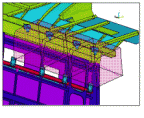Assessment of the interior of a railway vehicle is required to ensure the safety of passengers, particularly in a crash situation. MoreVision have extensive experience in supplying these calculations in particular for the refurbishment of London Underground's 73 tube stock (shown opposite) and the refurbishment of the Stansted Express. In addition MoreVision supports equipment suppliers in the preparation of calculations for new vehicles.
MoreVision has expertise in the analysis of composite honeycomb panel structures. These lightweight materials are commonly used for galley areas, toilet modules, doors and partitions.
 The animation opposite shows the first mode of vibration of a ceiling hung steam oven unit made from honeycomb panels (shown transparently to view mounting brackets and body structure). The steam ovens were very heavy and our client was not only concerned about the strength of the honeycomb panels but also the strength of the body structure. Resilient mounting brackets were included to isolate the unit from high frequency vibrations to reduce noise levels in the galley.
The animation opposite shows the first mode of vibration of a ceiling hung steam oven unit made from honeycomb panels (shown transparently to view mounting brackets and body structure). The steam ovens were very heavy and our client was not only concerned about the strength of the honeycomb panels but also the strength of the body structure. Resilient mounting brackets were included to isolate the unit from high frequency vibrations to reduce noise levels in the galley.
 Interior Doors, Partitions and Luggage Stacks. The picture opposite shows a finite element model of a full wall partition with a central door and two luggage stacks. It is constructed from composite honeycomb material, glass, aluminium and steel. The assembly included a number of bolted and riveted joints. The model was used for a static strength and fatigue strength check.
Interior Doors, Partitions and Luggage Stacks. The picture opposite shows a finite element model of a full wall partition with a central door and two luggage stacks. It is constructed from composite honeycomb material, glass, aluminium and steel. The assembly included a number of bolted and riveted joints. The model was used for a static strength and fatigue strength check.
Another relatively simple analysis but the strength of the table could be very important in a crash situation
Toilet modules will contain walls, doors and various pieces of equipment that each require assessment.
